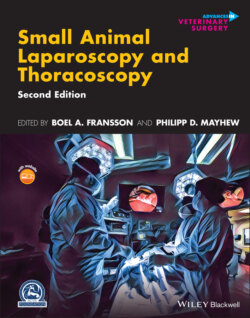Читать книгу Small Animal Laparoscopy and Thoracoscopy - Группа авторов - Страница 115
Port Closure Devices
ОглавлениеFormation of a postoperative trochar site herniation is considered a serious complication in human laparoscopic patients. Therefore, it has been recommended that 10 mm or larger cannula sites should be closed in adults and 5 mm or larger in children [20]. However, herniation has been reported in port sites as small as 3 mm [21]. In veterinary patients, the true incidence of such herniations has not been elucidated, and port closure recommendations are currently lacking. It seems generally accepted that all laparoscopic port sites in small animals should be closed by sutures engaging the rectus fascia whenever possible. However, like in people [22], port sites in small animals can be difficult to close in obese animals, or with obliquely oriented port sites.
For this reason, several methods have been developed to facilitate port closure under visual guidance, before or after cannula removal [22, 23]. A number of systems have been developed to facilitate closure. Most work by introducing suture under visual guidance to ensure appropriate closure of the site (Figure 4.24).
For port closure, the suture enters and exits the abdominal wall through the cannula site skin incisions, which are often quite small. To facilitate correct suture placement, many port closure systems include a suture guide (Figure 4.25).
Figure 4.25 Many port closure systems utilize a suture guide to facilitate placing the suture through the small cannula skin incision.
